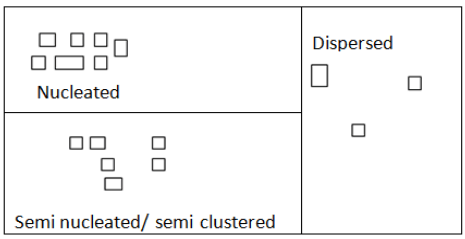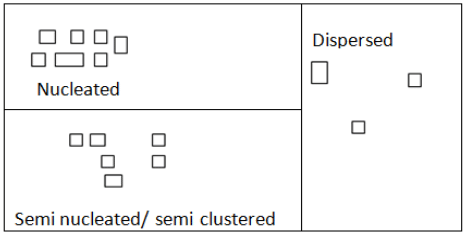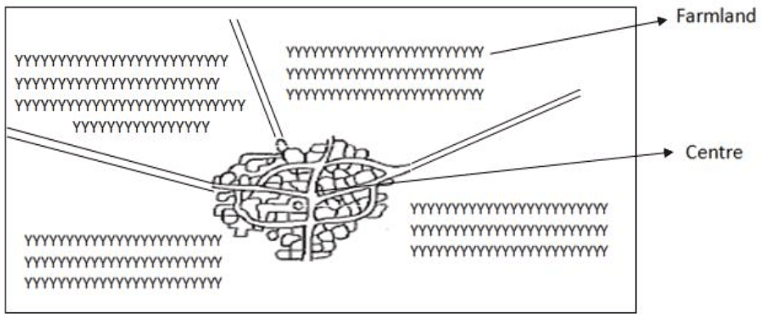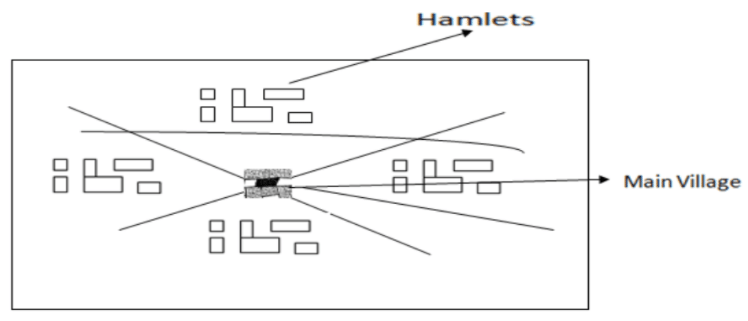Types and Patterns of Rural Settlements | Geography Optional for UPSC PDF Download
Types of Rural Settlement
- Rural settlement types are a way to categorize the arrangement of houses and villages in rural areas, taking into consideration social interactions, geographical conditions, and the ability of the land to support the population. The capacity of the land to accommodate settlements is directly related to the degree of nucleation, or the clustering of houses and villages.
- In the rural landscape, settlements can be found in various forms, such as villages, agricultural lands, and pasture lands. The types of rural settlements are determined by examining the spacing and arrangement of houses in relation to their geometric proximity across the landscape.
- To better understand and analyze rural settlement types, researchers use two statistical approaches: the nearest neighbor approach and the coefficient of dispersal method. These methods help to reveal patterns in the distribution and arrangement of settlements, providing insights into the factors that influence the development of rural communities.
1. Nearest neighbour approach
- In this approach, the degree of nucleation will be presented through an index value.
- It refers to the spacing between either houses or villages over the rural landscape.
Calculation of Index value
Rn is the index value which is derived from the formula
Rn = 2d√(n/A)
Where,
Rn – Index value
d = distance between either houses or villages
n = number of houses or villages
a = total Area of the given landscape under consideration

Coefficient of dispersal method
- Calculation of settlement type through this method is given below

- Above method signifies that greater the value of ‘C’ greater the dispersed settlement.
Based on above analysis, there are three types of settlement
- Nucleated/clustered
- Semi nucleated/ semi clustered
- Dispersed

Nucleated/clustered rural type
- Nucleated or clustered rural settlements are characterized by closely packed structures and a high degree of concentration. In these settlements, the rural houses or villages are densely populated, with an 'Rn' value of less than 1, which indicates little to no gaps between structures. There are various factors that contribute to the formation of nucleated settlements, including site factors, land capability, hydrology, defense, historical continuity, customs and beliefs, and homogeneous ethnicity.
- Site factors play a significant role in the development of nucleated settlements, as areas near water bodies and fertile lands tend to have higher populations. High land capability also leads to increased population density, as people look to utilize the potential of the land for agricultural and other purposes.
- Hydrology is another determinant of nucleation, with settlements often forming around water sources. Wet point settlements are those located around wells, ponds, lakes, and other water bodies, while dry point settlements can be found in desert areas, surrounding oases or other sources of water.
- Defense is another factor that contributes to the formation of nucleated settlements, as communities living in close proximity can protect themselves more effectively against enemies and natural threats. This is often seen in tribal communities, where fences are built around the settlement to keep out wild animals.
- Historical continuity also plays a role in nucleation, as the population of a particular area grows over time, leading to increased concentration and density of structures. Similarly, customs, beliefs, religious traits, and caste can influence the formation of nucleated settlements, as people who share the same traditions and cultural practices tend to live in the same area.
- Homogeneous ethnicity is another factor that leads to nucleated settlements, as people with a common ethnic background often prefer to live together in a concentrated area. An example of this is China Town in Kolkata, where people of Chinese descent have formed a close-knit community.
- In general, nucleated settlements often form around a central community place, such as a religious building or pond, and then expand outward as the population grows.

Distribution of nucleated settlements
- Nucleated settlements are concentrated communities primarily found in fertile alluvial plains. The need for collaboration in agricultural activities, such as tilling the land and sharing farming tools, brings farmers together. The uniformity of the landscape results in similar lifestyles, fostering a sense of unity among the inhabitants. This is further strengthened by socio-economic bonds formed through class, kinship, and other connections. Examples of such settlements can be found in the Indo-Gangetic plains, the Nile Valley, and the Huang He Valley.
- Hunting and fishing communities also have nucleated settlements due to the need for collective effort in building, maintaining, and operating fishing boats. Cooperation and effective management are essential in these communities, and as a result, compactness is necessary. This type of settlement can be observed among the American Red Indians and along the Brahmaputra and Hooghly river valleys.
- Security is another factor contributing to the formation of nucleated settlements. The need to protect inhabitants from wild animals and common enemies leads to the creation of compact communities. Examples of these can be found in the forests and valleys of Shiwalik, western and eastern India, Rajasthan, Punjab, and Bundelkhand. In Nagaland, compact settlements are located on hilltops and ridges to provide protection against invasions by headhunters.
- Scarcity of resources can also contribute to the formation of nucleated settlements. In areas where resources are limited, the compactness of a settlement allows for the maximum utilization of available resources. For instance, people in arid regions tend to settle around areas with water resources, such as oases in the Sahara desert and Rajasthan.

Distribution of nucleated settlement in India
- In India, intensive agriculture practices have led to the development of compact settlements. These densely populated areas, such as Purvas and Majras in the Ganga plains, are often the result of increased agricultural productivity. Similarly, planned villages in newly irrigated areas like Ferozpur in Punjab and Ganganagar in Rajasthan have also emerged as compact settlements due to intensive agriculture.
- In these settlements, essential facilities like marketplaces, shops, and religious places are typically located near the densely populated center. Furthermore, there is often a high degree of segregation along caste lines in rural areas with compact settlement types.
- Compact settlements are not unique to India and can be found worldwide. Examples of such settlements include the Northern Plains of India, cultivable tracts of Eastern China, Egypt, Pakistan, Bangladesh, Mexico, the North West European Plains, and Kenya. These regions share similar characteristics, such as being densely populated and having essential facilities located near the center, due to their reliance on intensive agriculture practices.
Semi-compact/Semi nucleated settlements
- In rural regions with limited land productivity, the landscape is typically composed of houses gathered in small clusters, known as hamlets.
- Due to the poor land capability, extensive agricultural areas are required to sustain smaller populations. To minimize travel distances and conserve time and energy, the population is spread out and dispersed across these areas.
- In these semi-compact or semi-nucleated settlements, the nucleation index (Rn) typically ranges from 1.5 to 2.5, indicating a moderate level of clustering.

- The hydrology of the area with a dispersed settlement type is poor.
- The area under dispersed settlement type is in a transitional phase in the growth of the compact settlement.
- With increasing population and adoption of new technologies, the scattered settlements starts taking the shape of semi-compact settlements.
- Examples of semi-compact settlements are
(i) East of Aravallis in Rajasthan
(ii) Hilly tracts of Madhya Pradesh, Arunachal Pradesh, Meghalaya, Manipur, Mizoram, Tripura, the valley of Brahmaputra.
(iii) Malwa plateau
(iv) Bundelkhand plateau
(v) Drier parts of Deccan plateau.
Dispersed or scattered settlements
- Dispersed or scattered settlements refer to villages with farmsteads spread over a much broader area, often indicating poor hydrology and land capability. These settlements have a ratio (Rn) greater than 2.5, meaning that there is a very low number of houses per unit area and a significant gap between them. Dispersed rural settlements are typically found in regions with extreme climates, hilly terrains, deserts, thick forests, grasslands, areas of extensive agriculture, or poor agricultural land. They are also common where it is essential for farmers to live on agricultural land rather than in distant village settlements.
- These settlements are often of a more recent age, as people move away from densely populated areas in search of new living spaces. Technological advancements have enabled people to inhabit desert regions as well. Dispersed settlements can be found in steppe grasslands in Uzbekistan and Russia, prairies in the US and Canada, the Pampas of Argentina, the Downs of Australia, and other extensive agricultural regions.
- In India, semi-desert regions of Rajasthan, forest lands of North East India, Shiwaliks, Jammu and Kashmir, and parts of Peninsular India have dispersed settlements. Similarly, underpopulated areas of northern Canada, Central Australia, Scandinavian countries, and the Western US also feature this settlement type.
- Some areas with productive land and favorable climates also have dispersed settlements due to historical or socio-cultural reasons. For example, when an overcrowded population leaves a village to establish a new settlement, it is often dispersed. Such settlements can be observed in the Northern plains between two large compact settlements. When people move into marshy lands, Khadar tracts, or marginal upland farms, they require a larger area for sustenance, resulting in isolated farms.
- Dispersed settlements are also found in areas such as the rain shadow region of the Western Ghats, Leh-Ladakh, Kutch, and Western Rajasthan.

Rural settlement forms
- Farmstead
- It includes a cluster of 2 to 3 houses.
- The regions having farmstead are the regions of extensive agriculture.
- Examples- Temperate grassland, Prairies, Downs.
- Hamlet
- It includes cluster of 7 to 9 houses
- It signifies poor land capability, low population density.
- It is found in Rajasthan, UK, Scotland
- Village
- It includes a cluster of more than 10 houses.
Classification of villages
- Pura
- The place where a habitat had been in ancient days and where chief habitats are all around or nearby areas is called Pura. These villages have great historical continuity.
- This habitat is the nucleus of the area.
- Khas
- It is also called as Sadate.
- It is the central village that was the center of revenue collection in medieval times.
- Kalan
- Kalan are the larger villages with huge clusters of houses.
- The word Kalan is used for large villages and used at the end of the name of the village i.e. Bound Kalan. People of several classes and castes live in such villages.
- Khurd
- Khurd villages are a small cluster of houses.
- This word is used for small villages
- Khera
- This word is used for small colonies and also for the higher land of the village. Khera has great social value for the village community because almost all the shows such as Ramlila Nautanki, etc. take place here.
- In some areas, the word Khera is used for those places where the rums of an ancient fort are found.
- Nanglay
- It comprises a group of small villages where one village is surrounded by several satellite villages.
Conclusion
In conclusion, rural settlements can be categorized into nucleated, semi-nucleated, and dispersed types based on their degree of clustering and distribution across the landscape. Various factors such as land capability, hydrology, customs, beliefs, and homogeneous ethnicity contribute to the formation of different types of settlements. The nearest neighbor approach and coefficient of dispersal method are used to analyze these settlement patterns. Nucleated settlements are concentrated communities found in fertile regions, while semi-nucleated settlements are characterized by small clusters of houses in areas with limited land productivity. Dispersed settlements, on the other hand, are found in regions with extreme climates, poor agricultural land, or extensive agriculture. Understanding the distribution and arrangement of rural settlements is crucial for effective planning and development of rural communities.Frequently Asked Questions (FAQs) of Types and Patterns of Rural Settlements
What are the three types of rural settlements?
The three types of rural settlements are nucleated/clustered, semi-nucleated/semi-clustered, and dispersed.
What factors contribute to the formation of nucleated/clustered settlements?
Factors that contribute to the formation of nucleated settlements include site factors, land capability, hydrology, defense, historical continuity, customs and beliefs, and homogeneous ethnicity.
What is the difference between a hamlet and a village in terms of rural settlement?
A hamlet is a small cluster of 7 to 9 houses, typically found in regions with poor land capability and low population density. A village, on the other hand, consists of more than 10 houses and often serves as a center for social and economic activities.
What are some examples of regions with dispersed rural settlements?
Dispersed rural settlements can be found in semi-desert regions of Rajasthan, forest lands of North East India, Shiwaliks, Jammu and Kashmir, and parts of Peninsular India. They can also be found in underpopulated areas of northern Canada, Central Australia, Scandinavian countries, and the Western US.
How do researchers analyze and categorize rural settlement types?
Researchers use two statistical approaches to analyze rural settlement types: the nearest neighbor approach and the coefficient of dispersal method. These methods help reveal patterns in the distribution and arrangement of settlements, providing insights into the factors that influence the development of rural communities.
|
304 videos|717 docs|259 tests
|
FAQs on Types and Patterns of Rural Settlements - Geography Optional for UPSC
| 1. What is the coefficient of dispersal method in relation to rural settlements? |  |
| 2. How are nucleated settlements distributed in rural areas? |  |
| 3. What are the different forms of rural settlements? |  |
| 4. How is the coefficient of dispersal calculated in rural settlement studies? |  |
| 5. What are some frequently asked questions about types and patterns of rural settlements? |  |






















